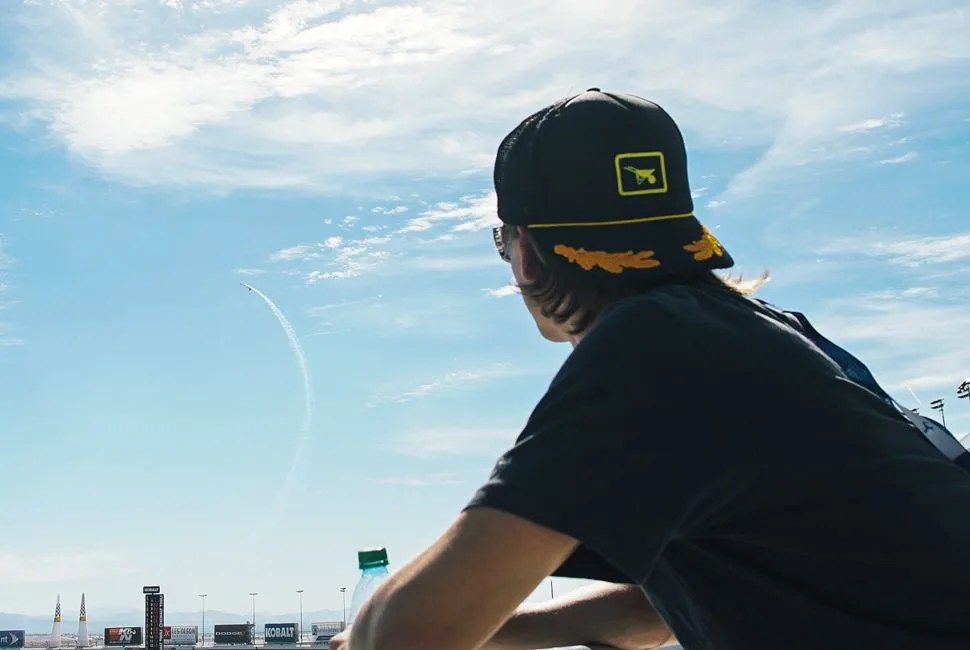 Gear Patrol
Gear PatrolAlready strapped in, with a stranger tightening my parachute, it becomes jarringly clear Red Bull race planes don’t have ejection seats. “In the event of an emergency, the canopy flies open, and I’ll be yelling ‘Bail! Bail! Bail!’” instructs François Le Vot, my French aerobatic pilot. His voice, competing against the engine through the helmet’s erratic mic, is hard to hear. There’s no chance I’m actually comprehending his words. As he progresses to some pretty vital details — how to unbuckle the safety harness; at which angle jump to avoid getting decapitated by the plane’s tail; where not to pull on my parachute — it’s all too much. I envision a fiery plane crash scenario. Is it unlikely? Yes. But it distracts me from another current crisis. For a person who doesn’t like flying, barrel rolls and controlled free falls scare me to the bones. And then there are the g-forces. I know there’s no way I’m ready for those.
The azure Las Vegas sky is calm, lucid and alarmingly inconsistent with my internal tempest. Somehow I agreed to this, but the whole situation feels rushed. In the seven minutes since arriving at the airstrip, I’ve slipped into a flight suit, met Le Vot and allowed myself to be gently shackled into a plane that’s slightly longer than a Suburban. Nothing’s been explained. Those safety waivers I signed in our New York office? Maybe I should’ve read them more meticulously.
“That’s the problem with the positive g-force. All the blood tends to leave the brain to go to the lower part of the body, and of course, no blood in the brain, no ideas.”
Someone closes the canopy and we start rolling down the runway. “Don’t worry”, Le Vot says. “You have little to fear. This plane runs like a Swiss-made watch.” If he means to calm me down, he fails. After two days listening to pilots, industry professionals and thrill seekers, I know my body’s going to be physically punished, no matter what, by g-forces. Loosely defined as the acceleration of gravity on a body, g’s are contingent on a plane’s speed and aerobatic prowess. Increased speeds and sharper maneuvers equate to higher pressures exerted on a pilot’s body. The Red Bull Air Race allows for up to 10 g’s, meaning that, for that moment, the pilot feels like he weighs ten times more than he actually does. To put that in perspective, pilots face the same amount force in a 50-second flight as a weightlifter benching a small car — twelve times.
As we take off and ascend into the sky, I’m vaguely aware we won’t reach the 10-g crescendo of an actual air race flight. But my body’s still in line for the ringer. Augmented g’s have a nefarious toll on the body. “That’s the problem with the positive g-force,” Le Vot had explained on the ground. “All the blood tends to leave the brain to go to the lower part of the body, and of course, no blood in the brain, no ideas.” Loss of consciousness — what pilots refer to as “greying out” — is a very real, very scary possibility.
But understanding g-force isn’t as deductive as simply staying under 10 g’s. There are two parameters to consider: the proper value of the g-force and the duration of their application. “For example, if you experience 5 g’s for 4 seconds,” says Le Vot, “that’s the same effort as experiencing 10 g’s for half of a second. Ten g’s isn’t a problem for half a second, but 5 g’s could become a problem after 10 seconds.”

